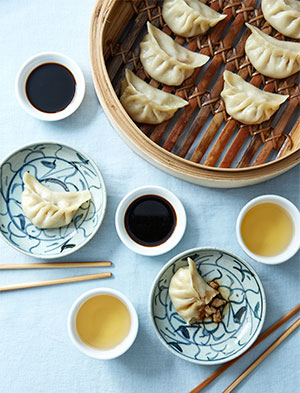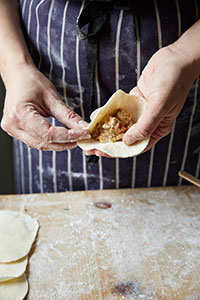Recipe: Anglo-Chinese pheasant dumplings

Simply sign up to the Life & Arts myFT Digest -- delivered directly to your inbox.
On Chinese New Year’s Eve, which falls this year on February 7, families across northern China will prepare one of their essential festive foods, the jiaozi or crescent dumpling. Grandparents, parents and grandchildren will all chip in, rolling pieces of wheaten dough into circles, and then pinching these neatly around a stuffing. Typically, jiaozi are filled with minced pork, with just the right amount of fat, and fine-chopped Chinese cabbage, garlic chives or another vegetable; the better-off may stir in some shrimps or even sea cucumber.
The jiaozi, made in China for more than 1,200 years, is a culinary concept of infinite possibility. You might make them as tiny as the thumbnail-sized jiaozi with which chefs tried to please the Dowager Empress Cixi when she fled after the Boxer Rebellion to Xi’an, or as big as the oversized New Year’s jiaozi eaten in some parts of Gansu province. If plain white dough doesn’t grab you, you can just colour it with the juice of spinach or carrot.
Ever since I spent Christmas as a student in Chengdu I have made my mince pies like jiaozi, pinching circles of rich shortcrust pastry around the mincemeat. Recently, I’ve gone in the other direction, making jiaozi with non-Chinese fillings, as here. Think of these as a kind of love-in between jiaozi, English game pie and Italian ravioli.

Like many steamed Chinese dumplings, these use a “scalded dough” (tang mian) made by adding wheat flour to boiling water. The boiling water tames the elasticity of the flour’s gluten, giving the dumplings a delightfully huggy texture. The dough is easy to roll and wrap, and doesn’t stick to an oiled steamer. Borrowing from English cookery, I’ve cut some pork belly into the pheasant filling to make it rich and unctuous (the pork skin, removed before serving, gives it a gentle set, which is essential). Veering back in a Chinese direction, I recommend serving the jiaozi with brown rice vinegar, although you can use chilli sauce if you prefer.
In some places, Chinese people hide a coin in the stuffing, which is supposed to bring good luck. Should anyone stumble across a stray piece of shot, you could pretend it means the same thing.
Fuchsia Dunlop’s most recent book is ‘Every Grain of Rice: Simple Chinese Home Cooking’
Anglo-Chinese pheasant dumplings
Makes about 30 dumplings.
Make the stuffing
- Joint the pheasant (ask your butcher or watch a video online if you’re not sure how). Slice the skin from the belly pork and reserve. Lay the pork on a board and cut across the layers of flesh and fat into 1cm slices, and then into 1cm strips.
- Fine-chop the onion and leek and cut the carrot into very small dice. Bring a kettleful of water to the boil. Heat 2 tbs oil in a frying pan. Add the chopped vegetables and fry over a medium heat until beginning to colour, stirring occasionally. Transfer into a saucepan large enough to contain all the ingredients.
- Wipe the frying pan. Return it to a high heat with another 1 tbs oil and fry the belly pork until tinged with gold. Transfer the pork to the saucepan, leaving as much oil as possible behind. Brown the pheasant in the frying pan, adding 1 tbs oil if you need it, and then transfer to the saucepan. Deglaze the frying pan with the wine and pour the juices into the saucepan.
- Add the bay leaves and enough hot water to cover the ingredients (about 700ml). Bring to the boil and season. Then half cover, turn the heat down low and simmer for 1½-2 hours, until the birds are tender. Taste again for salt (bearing in mind that the wrappers are unsalted).
- Remove and discard the bay leaves and pork skin. Strain the liquid into another container and skim off as much oil as possible. Remove the pheasant pieces from the pan. When cool enough to handle, extract and discard bones and cartilage, along with any shot. Cut the meat into 1cm dice. Return to the pot, along with the skimmed liquid. Mix well. Leave to cool and then chill overnight to set.
Make the wrappers
- Mix the flours in a bowl. Bring 350ml water to the boil in a deep saucepan. Turn off the heat, tip in about four-fifths of the flours and stir briskly with a wooden spoon until the mixture forms soft clumps. When cool enough to handle, dust a work surface with some of the extra flour, shape the clumps into a ball of dough and knead until smooth, adding more extra flour if necessary — you want a soft dough that does not stick to your hands. Cover with a wet tea towel if not using immediately.
- Take a fist-sized piece of dough and roll into a sausage 2.5cm thick. Cut or break off walnut-sized pieces (about 20g). Dust lightly with flour, then stand each piece, cut-sized up, on the surface and flatten to a disc with the palm of your hand. Repeat with the rest of the dough.
Assemble the dumplings
- Roll each disc into a circle about 9cm in diameter. The Chinese way is to use a narrow rolling pin and rotate the disc as you roll inwards from its edge, taking care not to roll over the centre of the disc.
- Place about 1 tbs (20g) stuffing in the centre of a disc and pinch the edges together to form a dumpling. Repeat. Lightly oil a steamer basket and lay the dumplings in well-spaced rows. Cover and steam over high heat for about 10 minutes. Serve immediately with Chinkiang vinegar or chilli sauce for dipping. The uncooked dumplings can also be frozen and steamed directly from the freezer (cooking time about 12 minutes).
Photographs: Tamin Jones
Comments